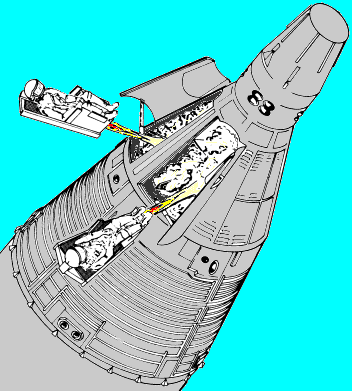 In the early days of the United States manned space program there were many unknowns and many
dangers to be faced. Sending a man into space was made dangerous not only by the hazards of
space itself, but also of the technology being developed to send him there. The rocket
engines were not perfected and the propellents were just as apt to expend themselves in a
large fireball at the pad as in the atmosphere paveing the way to orbit. While teams of
engineers worked feverishly to make the rockets reliable enough to be man-rated, other teams
of engineers worked on safely recovering the astronauts. Recovering the astronauts included
both the normal recovery from space, and any abnormal termination of the flight.
In the early days of the United States manned space program there were many unknowns and many
dangers to be faced. Sending a man into space was made dangerous not only by the hazards of
space itself, but also of the technology being developed to send him there. The rocket
engines were not perfected and the propellents were just as apt to expend themselves in a
large fireball at the pad as in the atmosphere paveing the way to orbit. While teams of
engineers worked feverishly to make the rockets reliable enough to be man-rated, other teams
of engineers worked on safely recovering the astronauts. Recovering the astronauts included
both the normal recovery from space, and any abnormal termination of the flight.
In the Mercury program this was accomplished by the use of a parachute (with manually deployable reserve) which would lower the entire capsule to the earth. Aborts were handled by an escape rocket system which would seperate the capsule from the rocket and lift it to an altitude where the parachutes could safely deploy. The capsule impact was further attenuated by a large airbag like device which would deploy by seperating the heat shield from the capsule and allowing its weight to pull down and inflate the bag. Holes in the sides of the bag would allow the air in for inflation, and meter the air out on impact in the same manner as airbags used for stunt jumps do.
The Gemini program used ejection seats for emergency egress. The seat was designed based on use during the pad, liftoff and late reentry stages. Once in upper atmosphere after launch the seat firing handle (located between the astronauts legs) was stowed out of the way so that it would not be inadvertantly actuated in space. The leg guards on the sides of the seat were retractable to allow more freedom in the cramped capsule once in space.
This seat used the most powerful ROCAT ever developed in the United States for propulsion. It was specifically designed based on a projection of the radius of the expected fireball should the Titan II rocket explode on the pad. The projection required the seat to outrun the fireball for a distance of about 800 ft fast enough that the nylon parachute would not be damaged by the heat pulse of the exploding fuel. The system was tested extensively by the technicians at Weber Aircraft. Boilerplate capsule mockups were launched at high speeds down sled tracks and seat ejections were filmed to verify high speed ejections were possible. Boilerplate capsules were mounted in launch attitude on top of a high tower and seats were fired across the desert to prove the 800 foot mark could be reached, and the parachute system would deploy properly.
Note that the Vostok capsules used in the earliest Russian human space flights had ejection seats as well. Those seats were actually designed to be used for the final stage of reentry. The cosmonaut would reenter the atmosphere in the capsule and descend under parachutes to an altitude in the 6000 meter range before ejecting from the capsule and descending under a personal parachute pack. This system was designed by Zvezda.
| The Ejection Site Home | |
|---|---|
| Send email to Kevin |